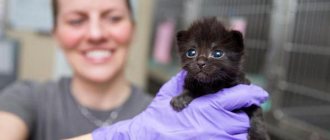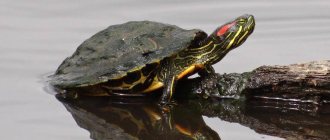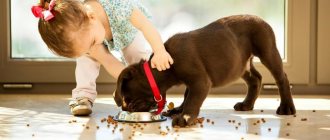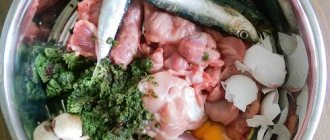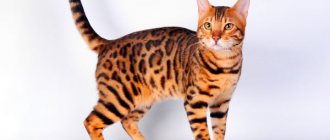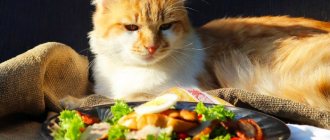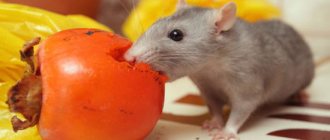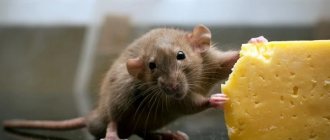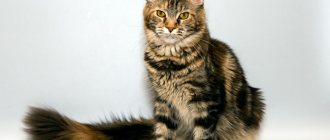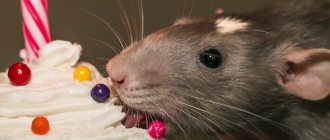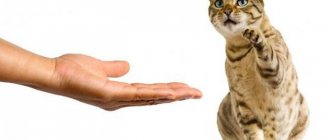What will you learn from the article?
- Feeding cats with prepared food
- Feeding cats natural food How many times to feed?
- How to feed a cat correctly
When your cat reaches the age of 1 year, it is time to completely switch to the diet and feeding regime of an adult animal. The thing is that the diet of a kitten and an adult cat is significantly different. In order to maintain health and a playful mood, read on about what to feed your cat. Main differences from kitten nutrition:
- firstly, adult cats need to be fed less often and in larger portions,
- secondly, the balance of nutrients, vitamins and minerals in food for babies and mature individuals also varies.
How to feed your cat properly with natural food
You cannot feed an animal food from a human table: a cat has its own digestive system, different from a human one, and therefore many human dishes can be harmful, lead to illness, and in some cases, the death of a pet.
A cat by nature is a predator, so the basis of its diet will always be protein foods. Hormonal levels and the production of enzymes, the stability of the immune system and the maintenance of water-salt balance depend on the consumption of protein, especially of animal origin.
A balanced diet should contain fats. They saturate the body with fatty acids, which are necessary for cell growth and regeneration.
Vegetables do not play a big role in the diet of cats, but they are a source of vitamins and normalize intestinal function, so it is necessary to introduce a small amount of vegetables into the diet, such as:
- carrot;
- cabbage;
- cucumbers;
- salad;
- pumpkin;
- zucchini.
Important! Cat foods are cooked or fed raw. To preserve the health of your pet, cooking methods such as frying, baking, and smoking are unacceptable.
Meat and offal
The basis of a healthy diet for representatives of the cat family is meat and meat by-products.
Cats can and should be fed the following meat products:
- Beef is the basis of the diet, the main thing is that it is not too fatty.
- Lamb, horse meat, and rabbit meat are quite acceptable in the diet of cats 2-3 times a week.
- Chicken or turkey can replace up to half of the meat diet. It is not advisable to feed poultry skin to cats: it contains too much fat.
- By-products - heart, kidneys, liver - are acceptable in the diet in moderation and pre-frozen.
Frozen meat must be thawed and doused with boiling water, warmed to room temperature and only then given to the animal.
Important! Pork is contraindicated for cats: it contains too much fat and is difficult to digest in the gastrointestinal tract.
Dairy products
Dairy products are necessary for the cat's body as a source of animal protein, but natural milk is practically not absorbed by the digestive system, since the body does not produce a special enzyme to break down lactose.
But fermented milk products, on which various bacteria and rods have already worked, are perfectly digestible:
- kefir;
- cottage cheese;
- fermented baked milk;
- low-fat sour cream;
- yogurt.
All these fermented milk delicacies can be present in a cat’s diet every day, but always in small portions; they cannot be made the main dish.
Attention! Do not give animals fermented milk products with a long shelf life with preservatives. Products suitable for cats have a short shelf life - from three days to a week.
Fish as a basis for natural food
The basis of natural feeding for a cat should still be meat. It will not be possible to completely replace it with fish. Thawed sea or ocean fish can be given two to three times a week, replacing meat with it. Raw fish is given to the animal along with the bones: this is beneficial for the functioning of the cat’s digestive tract.
Attention! In boiled fish, the bones must be removed, since the bone in the boiled mass is easily separated from the fibers and can be swallowed whole by the animal.
Other foods for a healthy diet
You can include porridge made from rice or buckwheat in your diet. But only occasionally and little by little, you cannot constantly feed the animal with cereals.
Cereals are not healthy for a cat’s diet: they contain too many carbohydrates, which can cause an imbalance in the digestive system and destroy the intestinal microflora, which will lead to dysbiosis and a decline in overall immunity.
Attention! A large amount of carbohydrates in a cat’s diet causes problems with the functioning of internal organs, can provoke allergic reactions and lead to excess weight gain.
Drinking regime
When asking how to properly feed an adult cat, you must remember that in addition to food, he must also receive a sufficient amount of liquid. Why do cats need water? The species of small feline predators, the distant ancestors of today's domestic cats, was evolutionarily formed in desert areas under conditions of severe lack of moisture; their body conserves liquid, so the urine of cats is naturally highly concentrated.
The problem is aggravated by the fact that they have a reduced sense of thirst - probably all owners of tailed friends have noticed that their pets drink a little. That is why fresh water should always be available to the animal. However, do not be surprised if the cat does not drink water from a bowl located next to the place where it eats. In the wild, representatives of the cat family do not drink water near the killed victim; they prefer to look for clean sources of drinking water in the distance. Many pets still have this instinct. It is best to place containers with water in different parts of the apartment - sooner or later the cat will find one or more places that are comfortable for itself.
Some cats prefer running water; in such cases, a special fountain that provides constant circulation and purification of water can be a solution. Some homeowners leave a small stream in the sink, but we do not recommend following this example unless the tap has a built-in filter. The fact is that tap water contains a lot of salts and impurities, which can lead to ICD.
The average daily fluid intake per 1 kg of animal should be 30 ml of water, but you need to take into account what kind of food the cat receives. With a dry diet, the amount of water should be 2-3 times greater than the amount of food eaten; when feeding with natural food or wet food, the need for drinking water is reduced. If your cat refuses to drink water, despite all your efforts, you will have to exclude dry food and try to compensate for the cat’s body’s need for fluid with wet food.
What not to feed cats
Cats eat food from the human table with enviable pleasure, and many owners watch with emotion as the animal happily treats itself to candy or a piece of chocolate, licks ice cream or eats a slice of melon, peach, tomato, sausage, or cheese.
Of course, a one-time consumption of a small amount of products that are exotic for the cat’s body is unlikely to lead to a serious illness, but you cannot constantly give such products to an animal: this can cause a chronic disease and significantly reduce the pet’s life expectancy.
The following foods should not be included in cat food:
- Fresh milk - this leads to impaired intestinal motility and indigestion.
- Food from the table - salt and seasonings contained in human food can even cause poisoning. And sausage, for example, contains soy products and a lot of fats, which are harmful to the cat's health.
- Sweets - carbohydrates are harmful to cats, since sugar is not processed at all by the digestive system.
- Coffee and alcohol are poisons for animals.
- Raw unprocessed meat and river fish - it is better to give the meat boiled or at least pour boiling water over it, since there is a high possibility of infection with helminths. River fish can be present in a cat's food only in boiled form, with selected bones.
- Pork – contains too much fat that the animal’s stomach may not be able to handle.
- Tubular or sharp bones - damage to the esophagus or stomach will definitely lead to the death of the pet.
Eating such products by an animal will inevitably lead to illness and deterioration in health.
Veterinarian advice
There are several tips that experienced veterinarians give to cat owners who want to feed their pets natural products:
- You cannot feed fermented milk and meat products to an animal at the same feeding. Fermented milk products are given at one meal, and meat at another.
- Fermented milk products can be given separately or mixed together; only bran or half a raw egg can be added to them.
- Meat feeding is either meat, fish, or offal. You should not mix foods in one feeding.
The cat should always have a bowl of clean, fresh water: the animal should be able to replenish the lack of moisture in the body when it needs it.
Flour foods and diabetes
If an animal has a disease such as diabetes, then flour food is strictly contraindicated for it. A carbohydrate-free diet is indicated for feeding animals with this disease.
Eating food high in carbohydrates will aggravate the disease and may lead to the death of the animal.
Attention! Cats are not recommended to eat food containing large amounts of carbohydrates.
Cat diet
Cats are naturally carnivores, meaning most of their diet should consist of meat products and, in the wild, caught rodents, birds and small animals.
Indoor cats with access to the outdoors often supplement their diet with mice and small birds. This diet is not safe, but it is almost impossible to “persuade” a cat from hunting. If a cat lives in an apartment, it eats only the food that the owner gives, but the need to “dilute” the diet does not go away.
Cats begin to more actively seek “alternative” food when:
- Vitamin deficiency.
- Worm infestation.
- At the stage of active growth.
As your cat tries different foods, it develops its own taste preferences. There are a number of foods that not all cats like, such as citrus fruits.
Important! Do not experiment with your pet's diet if he is prone to allergies.
Advantages and disadvantages of natural nutrition
Feeding your cat natural foods has its advantages and disadvantages.
The main disadvantages are:
- the difficulty of creating a balanced diet;
- the need to give the animal separate vitamin and mineral complexes;
- short shelf life of the finished dish.
Advantages:
- ability to control quality;
- lower cost of products compared to ready-made feed;
- natural products are closer to natural nutrition;
- absence of dyes and preservatives in food.
Proper home nutrition prevents the occurrence of chronic diseases and allows the cat to lead a more active lifestyle.
It should be understood that when deciding to feed your pet natural products, the owner will have to spend part of his free time preparing food for the animal.
Feeding cats with prepared food
▪ economy class (“Kitiket”, “Whiskas”, “Friskies”)
▪ premium class (Cat Chow, Sheba, Royal Canin, Hills, Nutra Mix)
▪ super premium class (“Acana”, “Kanide”)
Ready to buy? You will find a large selection of dry cat food in the Zooservice online store.
What is the difference between the above three classes of cat food?
Economy - made from cheaper second-grade raw materials. This class of food contains meat by-products and soy, which ensures the low energy value of such food. As a result, the cat needs large amounts of food to be satisfied. The content of preservatives, dyes and flavor enhancers is also high, so it is undesirable to feed the animal such food for a long time. When feeding economy class, additional vitamin and mineral supplements must be given.
Premium - in the production of such food, natural meat is used, but they cannot do without by-products. Vegetable protein - corn and a preservative with dyes are also added. Better than economy, so quite often such feeds are used for a long time. You can add vitamins and minerals by giving them in courses.
From personal experience, I’ll add that Sheba canned food is really quite good, because if it says on the jar that it contains food with mussels and shrimp, then there really is this seafood inside (I saw it myself).
Super Premium - the name of the class of these feeds speaks for itself. Such food is prepared from meat, is ideally balanced and contains all the necessary vitamins, minerals, and fatty acids. Vitamin E is a preservative in these foods, so they are ideal for proper nutrition for cats and are not only tasty, but also healthy. The only negative is that counterfeiting of such food is very common. Therefore, buy them in trusted stores and pay attention to the appearance of the packaging.
Also in the super premium class there are special therapeutic diets for cats with different body needs. But such food should be given only as prescribed by a veterinarian.
Features of the breeds:
- diet of British cats;
- what to feed a Maine Coon to grow;
- basics of proper nutrition for Siamese cats;
- what to feed a Persian cat.
Table: healthy and prohibited foods in a cat’s diet
The table below lists foods that can and cannot be given to a cat:
| Healthy | Harmful |
| Meat other than pork | Bread and flour products |
| By-products | Legumes and soybeans |
| Vegetables with low starch content | Potatoes and corn |
| Sea fish | Sweets |
| Cereals: rice and buckwheat | Chicken hollow bones |
| Dairy products | Fruits |
| Greenery | Fresh milk |
Special daily food for adult cats
The following products meet the cat's needs:
- Acana Wild Prairie Cat is made from fresh and dehydrated meat and giblets of chicken and turkey, containing fish components: herring meal, trout, pike perch. The amount of protein components reaches 75%, the rest is vegetables, fruits, herbs. Grain crops are replaced by peas, beans, chickpeas, and lentils.
- Orijen Cat & Kitten is intended for cats and kittens, 85% ingredients of animal origin, of which 40% fresh protein. There are no food additives; sources of vitamins are vegetables, berries, and fruits.
- Eukanuba Adult Top Condition contains 41% animal protein, it is represented by freeze-dried chicken meat, liver, and offal. Rice and wheat are sources of carbohydrates; valuable additives include fish oil and probiotics.
- Grandorf Adult Indoor is made from dried and fresh meat of turkey, duck, rabbit, and lamb. Useful additives include salmon oil, taurine, brewer's yeast, and flaxseeds. The food is suitable for cats with allergies; it does not contain wheat, chicken or corn, which often give a negative reaction.
- Fitmin cat For Life Salmon is created on the basis of fresh salmon and dried poultry, fish, and pork liver. Salmon oil, flax seeds are present, rice is used from cereal crops.
These foods are more expensive than economy-class products, but to satiate them you need 2 times less:
| Cat weight | Daily norm |
| Akana | |
| 2 | 40 |
| 3 | 45 |
| 4 | 60 |
| 5 | 75 |
| 6 | 80 |
| 8 | 90 |
| 10 | 120 |
| Orijen | |
| 2 | 35 |
| 3 | 45 |
| 4 | 65 |
| 5 | 65 |
| 6 | 85 |
| 8 | 100 |
| 10 | 115 |
| Eukanuba | |
| 2 | 25–35 |
| 4 | 50–70 |
| 6 | 75–105 |
| 8 | 100–140 |
| 10 | 125–170 |
| Grandorf | |
| 1,5–3 | 20–45 |
| 4–5 | 55–65 |
| 6–8 | 75–95 |
| Fitmin | |
| 2–3 | 24–45 |
| 3–5 | 35–75 |
| 5–7 | 65–95 |
| 7– 0 | 85–115 |
Dry granules are given twice a day, the norm per day is divided according to the number of meals. A proper diet or balanced industrial food will help maintain your cat’s health, positive mood and well-groomed appearance.
Natural menu for cats every day for 7 days
For an adult animal, it is enough to divide the daily diet into two times, especially if it lives in a small apartment and does not have the opportunity to walk.
Sample menu for the week:
- Breakfast - chopped beef mixed with grated vegetables, dinner - cottage cheese mixed with half an egg.
- Breakfast - boiled chicken with rice, dinner - a piece of liver or heart.
- Breakfast - cottage cheese with low-calorie sour cream, dinner - chicken necks.
- Breakfast - boiled boneless fish, dinner - grated vegetables and beef.
- Breakfast – chicken with buckwheat and chopped herbs, dinner – kefir and egg.
- Breakfast - offal and boiled rice, dinner - chicken necks.
- Breakfast - fermented baked milk and buckwheat, dinner - defrosted sea fish.
By alternating foods, you can feed your animal tasty and inexpensive, maintaining the balance of nutrients it needs.
Important! The owner must remember that a cat with a natural diet must be given vitamin and mineral preparations for preventive purposes.
conclusions
So, the health and longevity of a cat depends on a properly selected balanced diet. The basis for determining how to properly feed an adult cat is an understanding of its individual characteristics and the characteristics of its physiology as a biological species. Any cat, first of all, needs products of animal origin, supplemented with a vitamin and mineral premix. In general, any owner of a tailed friend is able to independently choose the right diet for their pet, however, in some cases, animals require a special diet, which can only be prescribed by a specialist.
How to switch an animal to natural food
It’s good when a kitten is accustomed to natural products from childhood, but it is quite possible to retrain a cat that is accustomed to dry food. If you change food suddenly, the animal may become stubborn, refuse to eat and go hungry for several days. To make the transition painless, you will have to try a little.
Natural food should be mixed in a small amount into the daily portion of dry food, replacing approximately 10% at first. Gradually, the share of natural food should be increased, and dry food should be reduced. After two weeks, you can completely switch to natural nutrition.
Features of nutrition of different categories of animals
Some categories of animals have their own feeding habits depending on age and position.
Sterilized pets
Portions for spayed and neutered pets must be strictly adjusted. Such animals should not be overfed. If the animal gains excess weight, then you need to reduce the portion or switch to foods with lower calorie content.
Kittens
Milk should be present in the kitten’s daily diet; meat is given ground in a blender or meat grinder; the daily portion is divided into 5-6 meals.
Pregnant and lactating cats
The nutrition of a pregnant and lactating cat must be enhanced; you need to rely on the animal itself and the kittens that it carries and feeds.
Attention! After the animal eats food, the cup with leftover food must be removed; the food should not sit and sour all day.
Sample recipes for cats
Cooking for cats is not difficult, the main thing is that you don’t need to add salt, pepper or sugar:
- Mix low-fat cottage cheese with half a chicken egg, and the dish is ready.
- Finely chop the vegetables, boil and mash with a fork, add finely chopped meat or minced meat, a few drops of vegetable oil. You can give it in the form of porridge, or you can dilute it with broth.
- Finely chop the offal and mix with finely grated vegetables.
- Cut the chicken meat into pieces and boil for ten minutes in a small amount of broth, add a little buckwheat or rice and after a couple of minutes turn off the stove, leave under the closed lid for about twenty minutes.
It is not necessary to cook for your pet at once; you can store the prepared food in the refrigerator. Warm the food to room temperature before serving.
